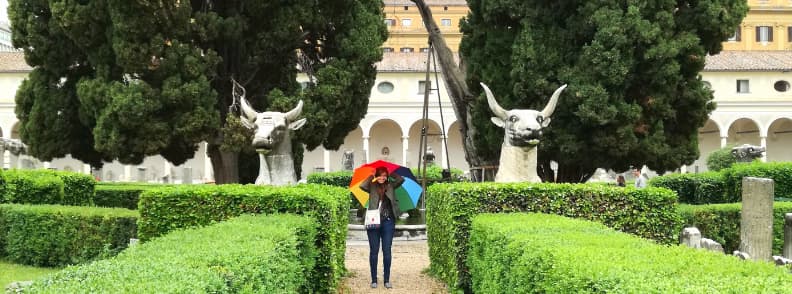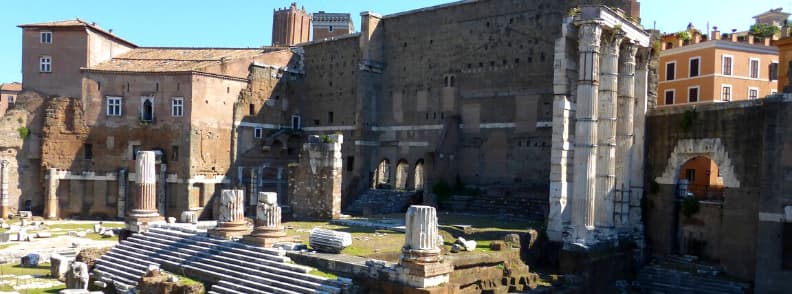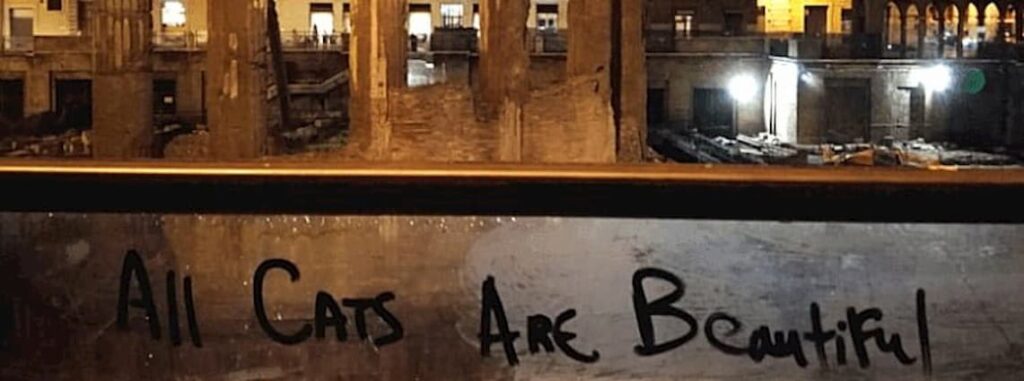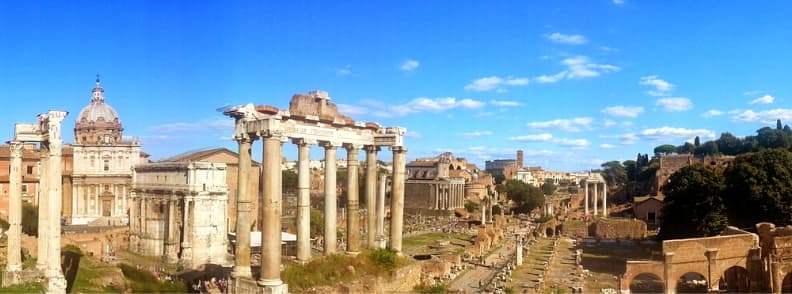On this page of The Travel Bunny’s free Rome travel guide, you’ll find all of Rome’s archaeological sites you should visit during your trip to Italy. For all Rome archaeological sites, you have:
- an image and the name of the Rome archaeological site;
- a short description of the archaeological site;
- visiting information, including opening times, ticket prices, address and map location, telephone number when available, plus some details on how to get to these Rome archaeological sites with public transport.

Baths of Caracalla (Terme di Caracalla)
Today, the Baths of Caracalla are in ruin, but they once housed art galleries, libraries, brothels, and even gym halls. The baths themselves included an area for steam bathing, one for cooling, and a pool to take bathe in cool water. These Roman baths could accommodate up to 2000 people at the same time.
The Baths of Caracalla were opened to the public in the year 217 and they were functional until the year 547 when the Goths ruined the aqueducts serving them.
The Baths of Caracalla is well-known among Rome archaeological sites thanks to the collection of ancient sculptures of the Farnese family that was discovered here.
Tickets, opening times, and other useful information
Opening Times
The Baths of Caracalla are open daily, starting at 09.00. In late spring and summer, closing times vary between 19.00 and 19.15. In autumn, they close between 18.30 and 19.00, and in winter and early spring between 16.30 and 17.00. The Baths of Caracalla are closed on Mondays after 14.00.
Tickets
A full general admission ticket costs €13.00.
Reduced tickets cost €5.00 and they are provided for visitors between ages 6 and 17 years.
Free access is provided to all children under 6 years.
With your ticket to Caracalla’s Baths, you can also visit the Tomb of Cecilia Metella and Quintili’s Villa, on the Via Appia. And, while you have to visit the Baths of Caracalla on the day you bought the ticket, you can visit the other two attractions within seven days. Book your ticket online here and skip the line when visiting these famous Rome archaeological sites!
Baths of Caracalla
Address: Viale delle Terme di Caracalla, 00153 Roma RM, Italy | See on map
Public transport: Subway line B can take you as far as Circo Massimo. Buses 118, 160, and 628 also stop close to the Baths of Caracalla.
Tel. +39 06 3996 7702

Baths of Diocletian (Terme di Diocletiano)
Today you can visit here the ruins of the rooms in the Baths of Diocletian, similar to those found in the Baths of Caracalla. The 3rd-century complex is also home to an archaeology museum. Inside, you can find a large collection dedicated to various inscriptions and burial stones. In Aula Ottagona, you can admire a 2nd-century BC bronze sculpture, found under the floors of the Temple of the Sun of the Quirinale.
In the interior courtyard of the Baths of Diocletian, you can admire one of Michelangelo’s works of art.
Tickets, opening times, and other useful information
Opening times
The Baths of Diocletian are open from Tuesday to Sunday, between 09.00 and 19.30. Closed on Mondays.
Tickets
A full general admission ticket costs €13.00.
Reduced tickets cost €2.00 and are offered to EU citizens with ages between 18 and 24 years.
Free access is provided to children and seniors from the EU.
The ticket for the Baths of Diocletian is also valid for the other three other Rome archaeological sites and buildings of the National Roman Museum: Palazzo Altemps, Palazzo Massimo alle Terme, and Crypta Balbi.
From what we saw, the National Roman Museum isn’t crowded enough to book tickets online. Though the option is available, it’s €4.00 more expensive than buying it on the spot.
Baths of Diocletian
Address: Viale Enrico de Nicola, 78, 00185 Roma RM, Italy | See on map
Public transport: Subway lines A and B to Termini station. Buses C2, H, 36, 38, 40, 64, 86, 90, 92, 105, 170, 175, 217, 310, 360, 714, and 910 also stop close to here.
Tel. +39 06 480201

Forum Boarium (Foro Boario)
Dating back to the time of Emperor Constantine, Forum Boarium actually takes its name after the old cattle market. Today, in this small archaeological park you can still see the remains of its 2nd-century BC temples. The rectangular altar was dedicated to god Portunus or Portumnus, protector of rivers and ports. The circular altar was dedicated to Hercules.
Opening times and other useful information
Opening times
Forum Boarium is accessible at any hour.
Tickets
The entrance to this Rome archaeological site is free of charge.
Forum Boarium
Address: Via della Greca, 00186 Roma RM, Italy | See on map
Public transport: Buses 44, 81, 95, 160, 170, and 628 stop at the nearby Piazza Bocca della Verità.
Tel. +39 06 0608

Forum of Augustus (Foro di Augusto)
Emperor Augustus succeeded Caesar in the ruling of Rome. The main attraction of this Rome archaeological site is the Temple of Avenging Mars. You can easily make it out thanks to its 4 Corinthian columns and its wide staircase.
Tickets, opening times, and other useful information
Opening times
The Forum of Augustus can be admired from the outside at all times. However, in the evenings, access is granted inside this Rome archaeological site to see videos and reconstructions. These visits last about 40 minutes and they take place every hour.
Tickets
A full general admission ticket costs €16.00.
Reduced tickets cost €11.00 and are offered to children and young adults under 26 years.
Save money with the combined ticket of €31.00 (reduced €19.00)! The combined ticket covers tours to both Rome archaeological sites: the Forum of Augustus and the Forum of Caesar.
Book single or combined tickets here.
Forum of Augustus
Address: Piazza del Grillo, 1, 00184 Roma RM, Italy | See on map
Public transport: Subway line B to Colosseo station.

Forum of Caesar (Foro di Cesare)
The Forum of Caesar is the first imperial forum to ever be built in Rome. It was said that the Giulia family descended from the goddess Venus. This is why Caesar raised the Temple of Venus Genetrix here, in the year 46 BC. Inside it, he placed a statue of himself with empress Cleopatra, the love of his life.
Tickets, opening times, and other useful information
Opening times
The Forum of Caesar can be admired from the exterior at all times. However, in the evenings, access is granted inside these Rome archaeological sites for visitors, to see videos and reconstructions. These shows last about 40 minutes and they take place every hour.
Tickets
A full general admission ticket costs €16.00.
Reduced tickets cost €11.00 and are offered to children and young adults under 26 years.
Save money with the combined ticket of €31.00 (reduced €19.00)! The combined ticket covers tours of both Rome archaeological sites: the Forum of Augustus and the Forum of Caesar.
Book single or combined tickets here.
Forum of Caesar
Address: Via dei Fori Imperiali, 00187 Roma RM, Italy | See on map
Public transport: Subway line B to Colosseo station.
Tel. +39 06 0608

Golden House of Nero (Domus Aurea)
Domus Aurea is what remains of Nero’s excentrical palace, the most sumptuous one to ever be built in Rome. On the grounds Nero took from the Romans, he even had his own lake and forest.
The Emperors who succeeded Nero on the throne weren’t pleased with his construction. Not only did they give back part of the lands to the Romans, but those from the Flavia family drained the lake and built the Colosseum in its place. Then, Trajan built the first Roman baths on top of the Golden House of Nero.
What remained of the Golden House of Nero was discovered by archaeologists close to the end of the 1400s. Inside, they discovered strange murals, and their style came to be known as grotesque. This style was fancied by many artists of the Renaissance, including grandmasters like Raphael.
Tickets, opening times, and other useful information
Opening times
The Golden House of Nero is open on Saturdays and Sundays, between 09.15 and 16.15. Reservations required.
Tickets
A full general admission ticket costs €14.00.
Free access is provided to children under the age of 6 years.
You must pre-book a didactic tour to visit the Golden House of Nero.
Golden House of Nero
Address: Via della Domus Aurea, 1, 00184 Roma RM, Italy | See on map
Public transport: Subway line B can take you to the nearby Colosseo station. Buses 85, 87, 175, 810, and 850 stop close to the Golden House of Nero, as well.
Tel. +39 06 3996 7700

Largo di Torre Argentina
In 1924 archaeologists uncovered the remains of four temples, one of them dating back to the 4th century BC. Behind one of them, there is the gutter to drain the public latrine of those times. And behind the other three, there is the Pompei’s Curia, the Senate House where Caesar got stabbed and dies on 15 March 33 BC.
Largo di Torre Argentina is today a cat sanctuary, thanks to the initiative of Dr. Silvia Viviani. With the slogan “do not kill”, the sanctuary survives thanks to its devoted volunteers. The Cat Sanctuary at Largo di Torre Argentina encourages tourists to visit and even adopt their cats.
Opening times
Largo di Torre Argentina is closed to visitors until restoration works are completed. This Rome archaeological site can still be admired from the exterior.
Largo di Torre Argentina
Address: Largo di Torre Argentina, 00186 Roma RM, Italy | See on map
Public transport: Subway line A and buses 30, 64, 70, 87, 105, and 628 will bring you next to Largo di Torre Argentina.

Palatine Hill
Palatine Hill stands tall at 40 meters over the Roman Forum. Once the hill where the palaces of emperors were raised, it is now another large Rome archaeological site to explore. In most European languages, the word denoting palaces comes from the name of the Palatine Hill.
What to visit on the Palatine Hill
- Farnese Gardens (Orti Farnesiani). These huge garden with elegant aviaries and beautiful plants were conceived by Vignola. The Farnese Gardens were built in the 16th century at the orders of Cardinal Alessandro Farnese, on the ruins of the palace of Tiberius.
- Temple of Cybele (Tempio della Magna Mater). The orgy cult of the Great Mother was one of the first oriental religions that arrived to Rome. Its priests were castrated.
- House of Romulus (Casa Romuli). These huts are part of an Iron Age settlement, discovered by archaeologists in the year 1940. Legend says that the village that was on the Palatine Hill during the Iron Age was founded by Romulus. Rome is supposed to take its name after him.
- House of Livia (Casa di Livia or Villa Ad Gallinas Albas). Built in the 1st century BC, the house is now located below the current ground level. It used to be part of the residence of Augustus and his second wife. The Latin name means house with the white hens, a reference to the breed of white chicken they had there.
- Cyptoportico. These underground tunnels with decorated arches united the Palatine Hill to the Domus Aurea, the Golden House of Nero. They have a length of 130 meters.
- Domus Flavia. This used to be the official wing of Domitian’s imperial palace, raised in the year 81. It’s easy to spot as its presence is signaled by the ruins of two fountains.
- Palatine Museum and Antiquarium. In this museum of Rome, you can admire large collections of artifacts and a model of the Palatine Hill in the Iron Age. Read more about the Palatine Museum.
- Domus Augustana. Only the substructure arches remain today from what used to be the private wing of Domitian’s palace.
- The Stadium. Once a horseracing track, this rectangular structure is now under the current ground level. It was once a part of Domitian’s palace.
- Dome of Septimius Severus. These grand arches and walls in ruin are all that is left of this wing of the Domus Augustana.
Tickets, opening times, and other useful information
Opening times
The Palatine Hill is open daily, between 08.30 and 19.00.
Tickets
A full general admission ticket to these Rome archaeological sites costs €12.00.
Reduced tickets cost €7.50 and are offered to EU citizens.
Free access is provided to children under 17 and seniors over 65 years from the EU.
Combined ticket for Rome archaeological sites:
The ticket to the Palatine Hill is also valid for the Roman Forum and the Colosseum.
Palatine Hill
Address: 00186 Rome, Metropolitan City of Rome, Italy | See on map
Public transport: Subway line B will take you to Colosseo station. Buses 60, 75, 84, 85, 87, 117, 175, 186, 271, 571, 810, and 850 also stop at the Colosseum.

Roman Forum (Foro Romano)
Over 3000 years ago, in the place where the Roman Forum’s ruins are now, you will have found a cemetery, built over a swamp. This cemetery is where they used to bury the deceased from Palatine Hill.
In the 6th century BC, they took the water out and buildings were raised out of brick. The Roman Forum became truly elegant by the order of Emperor Augustus, who turned the brick city into one made of marble.
The Roman Forum used to be the center of political, judicial, and commercial powers. Today, however, it is a large space where only some of its grand arches, majestic columns, and detailed sculptures have stood the test of time. It is the most popular of all the Rome archaeological sites.
What to visit in the Roman Forum
Below is a list of what you should see when you visit the Roman Forum. All of these places are listed in the order in which you will encounter them as you enter the Roman Forum and start exploring it.
- Via Sacra. Paved with smooth black basalt, Via Sacra is the oldest road of Rome. It stretches from the Arch of Titus all the way to the Capitol Hill. The heroes of Rome used to march on Via Sacra while the people cheered for them. Later on, it turned into a meeting spot of pocket thieves and outlaws.
- Arch of Titus (Arco di Tito). This arch was raised by Emperor Domitian in the honor of his brother, Titus, and his father, Vespasian. It’s a symbol to celebrate their victory over the jews. If you look closer at its frescoes, you will see Roman soldiers robbing the city of Jerusalem. Among the sacred objects that they took you can even spot a menorah.
- Basilica of Constantine and Maxentius (Basilica Nova or Basilica of Maxentius). This building had three tall arched rooms, and you can still make out most of its shape from what remains today. The Basilica of Constantine and Maxentius is the construction that stood at the foundation of the Roman Forum in 315. It used to house the legislative and financial center of the Roman Empire.
- Temple of Romulus (Tempio dei Divo Romolo). This temple is dedicated to Valerius Romulus, the son of Maxentius. Despite its name, it seems it was actually the office of the urban praetor.
- Temple of Antoninus and Faustina (Tempio di Antonino e Faustina). One of the best-preserved temples in the Roman Forum, it is dedicated to Antonius Pius and his wife, Faustina. In the 7th century, the temple was turned into a church dedicated to San Lorenzo in Miranda. On the sides, the building still has some interesting sculpted griffins.
- Basilica Emilia (Basilica Aemilia). Founded in the year 179 BC, the building was restored several times in the reign of Augustus. Back then, however, it was a place where people would engage in commercial activities while being protected from the weather elements. Today, all that remains is the plan of the building and some rebuilt elements.
- The Senate House (Curia Julia). You can still see the original floor and some of the seats in which the 300 senators once sat during the senate debates. Near it, you can spot the Rostra (Rostri), from where the politicians addressed the public.
- Arch of Septimius Severus (Arco di Settimio Severo). Very well preserved to this day, the Arch of Septimius Severus was raised in 203 BC to celebrate the Middle East victories of the Emperor.
- Temple of Vespasian and Titus (Tempio di Vespasian e Tito). Raised in the year 81 by Domitian, the temple only has three columns still standing nowadays. They were part of the hexagonal pronaos of the building. These columns stayed hidden under the rubble until the 18th century.
- Temple of Saturn (Tempio di Saturno or Aedes Saturni). Only 8 ionic columns remain from the Temple of Saturn. Once the state treasury, it was raised to honor the protector of agriculture.
- The Column of Phocas (Colonna di Foca). Dedicated to Emperor Phocas, it is the last construction raised in the Roman Forum.
- Basilica Julia (Basilica Giulia). Not much remains today from what used to be the largest and most luxurious construction of the Roman Forum.
- Temple of Vesta (Tempio di Vesta) and the House of the Vestals (Atrium Vestae). This gracious temple and the nearby palace were where the Vestals spent their days. The Vestals were noble priestesses who kept the flame of the sacred fire always burning. Worshiped by all, they enjoyed the highest privileges in Rome.
- Temple of Castor and Pollux (Tempio dei Dioscuri). The temple was raised to honor the twin sons of Helen of Troy, but also the sons of Jupiter and Leda. The altar of the temple is said to be the place where the two made a miraculous appearance in 499 BC to foretell an important victory for Rome.
During summer, visit the Forum early in the morning or around sunset to avoid the heat
Tickets, opening times, and other useful information
Opening times
The Roman Forum is open daily, between 08.30 and 19.00.
Tickets
A full general admission ticket costs €12.00.
Reduced tickets cost €7.50 and are offered to EU citizens.
Free access is provided to children under 17 and seniors over 65 years from the EU.
Combined ticket for Rome archaeological sites:
The ticket to the Roman Forum is also valid for the Palatine Hill and the Colosseum.
Roman Forum
Address: Via della Salara Vecchia, 5/6, 00186 Roma RM, Italy | See on map
Public transport: Subway line B will take you to Colosseo station. Buses 60, 75, 84, 85, 87, 117, 175, 186, 271, 571, 810, and 850 also stop at the Colosseum.
Tel. +39 06 699841

Trajan Forum and Market (Foro di Traiano and Mercati di Traiano)
Could this have been the first mall in the world? Emperor Trajan built this then-modern commercial center with his architect, Apollodorus of Damascus at the beginning of the 2nd century. Back then, it had 150 rooms. Its last floor had support offices, while all of its lower floors were filled with shops.
Its contemporaries considered it a wonder of the world. Today only Trajan’s Column is left standing here in one piece. A visit to Trajan’s Market, however, will take you through the restored Roman city forum complex.
Tickets, opening times, and other useful information
Opening times
Trajan’s Market is open daily, between 09.30 and 19.30.
Tickets
A full general admission ticket to these Rome archaeological sites costs €15.50.
Free access is provided to children under the age of 5 years and visitors with disabilities.
Combined ticket for Rome archaeological sites:
The ticket to Trajan’s Market includes access to the Imperial Forums Museum.
Trajan’s Market
Address: Via Quattro Novembre, 94, 00187 Roma RM, Italy | See on map
Public transport: Subway line A and buses 30, 64, 70, 87, 105, and 628 will bring you within walking distance.
Tel. +30 2103 210 185

Vicus Caprarius — The Water City
Two streets away from the Fontana di Trevi, there is Vicus Caprarius, also known as the Water City. Located under a tiny cinema, this is one of the smallest Rome archaeological sites.
A visit to Vicus Caprarius will help you better understand the old plumbing systems of Rome.
Tickets, opening times, and other useful information
Opening times
Vicus Caprarius – The Water City is open from Monday to Friday between 11.00 and 17.30, and on Saturday and Sunday between 11.00 and 19.00.
Tickets
A full general admission ticket costs €3.00.
Reduced tickets cost €1.50 and are offered to students between 18 and 25 years, senior citizens over 65 years, EU teachers, and Roma Pass holders.
Free access is provided to children under 14, architecture university students, and Rome City Pass holders.
Vicus Caprarius – The Water City
Address: Vicolo del Puttarello, 25, 00187 Roma RM, Italy | See on map
Public transport: Subway line B and buses 75 or 85 will take you close to Vicus Caprarius – The Water City.
Tel. +39 339 778 6192
Rome archaeological sites also available on GPSmyCity.

